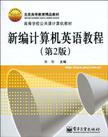新编计算机英语教程
2010-5
电子工业出版社
张政 编
284
北京市精品教材《新编计算机英语教程》自2004年出版后,得到众多读者的厚爱,已多次印刷。期间也收到不少读者中肯的建议,并对书中的个别不当之处也提出了宝贵的意见,加之计算机科学的新发展,这些都是促使我们进行修订的主要因素。修订后的教材除保留第一版中的优点外,还具备以下特点: 1.文本遴选更偏重语言的权威性和趣味性:所有文本均选自英美原文,语言地道,文字优美,使人乐知、好知。 2.注重文本的时效性:修订后的教程除保留了计算机科学发展中一些至今仍引人入胜的章节外,还增加了关于该领域发展中的部分最新内容,如在计算机及其种类一文中,增加了DNA计算机、光子计算机、量子计算机的相关知识,尽力做到文献内容“引领潮流,高屋建瓴”。 3.知识性、实用性为教程成功的关键之一:修订后的教材,更是力争覆盖计算机知识的关键领域,从早期的计算机的基本原理到8核处理器,使之俨然成为一部计算机英语的小百科;计算机知识、相对应的英语语言、所涉及的短语、词汇……力求“教程在手,应有尽有”。 4.富含计算机文化:相关的文化知识是任何教材都不可或缺的内容之一,因此计算机文化部分在新教程中有所加强,旨在为使用者成为计算机文献中的“文化人”助上一臂之力。 由于作者水平、时间等诸多因素的限制,书中难免存在不当之处,敬请读者不吝赐教。 本书被评为北京高等教育精品教材,成书的全过程得到了北京市教委的大力支持和资助。在此,我们再次表示衷心感谢。
本书为北京高等教育精品教材。全书共6章,前5章包含15个单元,每个单元都包含课文、摘要、单词、短语、注释、练习和阅读材料几个部分,课文和阅读材料的素材取自英美原文,内容涉及计算机技术相关的各个领域;第6章详细阐述了科技文献,特别是计算机文献撰写的知识和技巧;附录中收录了计算机词汇的特征和各章练习的参考答案。 本书英文短文取材新颖,涉及知识全面,撰写科技文献的有关知识阐述细致,实用性很强,计算机词汇的特征也有较高的阅读价值。 本书可作为高等学校计算机及相关专业的专业英语课程的教材,也可供计算机或英语受好者学习和参考。
第1章 计算机硬件 Unit 1 Computer and Its Kind(计算机及其种类) Abstract New Words Phrases and Expressions Notes Exercises Reading Material ATM System(自动提款机系统) Unit 2 Secondary Storage Media(辅助存储介质) Abstract New Words Phrases and Expressions Notes Exercises Reading Material Data Storage Device(数据存储装置) Unit 3 The Future of Your PC(PC的未来) Abstract New Words Phrases and Expressions Notes Exercises Reading Material Broadband(宽带)第2章 计算机软件 Unit 4 The Operating System(计算机操作系统) Abstract New Words Phrases and Expressions Notes Exercises Reading Material Multitasking(多任务处理) Unit 5 Computer Languages(计算机语言) Abstract New Words Phrases and Expressions Notes Exercises Reading Material AgentSheets(视觉化程式设计语言) Unit 6 Database and Database Management(数据库及数据库管理) Abstract New Words Phrases and Expressions Notes Exercises Reading Material E-Business(电子商务)第3章 计算机应用 Unit 7 Multimedia(多媒体) Abstract New Words Phrases and Expressions Notes Exercises Reading Material Health Care Delivered at a Distance(网上)远程医疗保健 Unit 8 Artificial Intelligence (人工智能) Abstract New Words Phrases and Expressions Notes Exercises Reading Material Machine Translation(机器翻译) Unit 9 The Evolution of ERP Systems(企业资源计划) Abstract New Words Phrases and Expressions Notes Exercises Reading Material Online Education(网上教育)第4章 网络与信息安全 Unit 10 Electronic Network(电子网络) Abstract New Words Phrases and Expressions Notes Exercises Reading Material Making a Homepage(设计自己的网页) Unit 11 Cybersecurity(网络安全) Abstract New Words Phrases and Expressions Notes Exercises Reading Material Computer Security(计算机安全) Unit 12 Evolving Firewalls(防火墙的变迁) Abstract New Words Phrases and Expressions Notes Exercises Reading Material Software Security(软件安全) Unit 13 The Threat of Internet Worms(蠕虫的威胁) Abstract New Words Phrases and Expressions Notes Exercises Reading Material Computer Viruses(计算机病毒)第5章 计算机文化 Unit 14 Turing Award & ACM(图灵奖与美国计算机学会) Abstract New Words Phrases and Expressions Notes Exercises Reading Material IBM—A Brief History(IBM发展史) Unit 15 The Superior Intelligence(超级智能) Abstract New Words Phrases and Expressions 209 Notes Exercises Reading Material Information Technology Law(信息技术保护法)第6章 论文写作 6.1 总论 6.1.1 什么是学术论文? 6.1.2 学术论文的特点 6.1.3 为什么要用英文写作学术论文? 6.1.4 学术论文的概要 6.2 标题的写作技巧 6.2.1 标题的长度 6.2.2 标题的结构 6.2.3 标题的用词 6.2.4 论文署名 6.3 摘要的写作技巧 6.3.1 摘要的概念和作用 6.3.2 摘要的种类与特点 6.3.3 摘要的内容与结构 6.3.4 英文摘要的语言问题 6.3.5 期刊论文摘要 6.3.6 学位论文摘要 6.3.7 摘要中的常用句型 6.4 关键词的写作技巧 6.4.1 关键词与主题词 6.4.2 关键词的一般选择方法 6.5 引言的写作技巧 6.5.1 引言的内容与结构布局 6.5.2 如何撰写引言的开头 6.5.3 如何撰写文献综述 6.5.4 如何撰写研究动机与目的 6.5.5 如何撰写引言的结尾 6.6 正文的写作技巧 6.6.1 描述研究方法 6.6.2 描述方法时的语言特点 6.6.3 描述公式与图 6.6.4 描述研究结果 6.6.5 图表及文字说明 6.6.6 讨论部分的写法 6.6.7 语言运用技巧 6.6.8 讨论中的用词技巧 6.7 结论的写作技巧 6.7.1 结论部分的内容与结构布局 6.7.2 结论部分的语言运用技巧 6.7.3 结论中的用词技巧 6.8 如何撰写致谢 6.9 如何撰写参考文献 6.9.1 顺序编码体系 6.9.2 作者 + 出版年体系 6.9.3 各类文献的基本格式附录A 计算机词汇的特征附录B 参考答案参考文献
With breakthroughs such asfaster multicore processors on the way,raw PC muscle isabout to return with a vengeance.And it will come in more shapes and sizes than ever ——Christopher Null The PC of tomorrow will have more competition than ever in winning a place at the heartof your technological universe.But that doesn’t mean that the PC will wither away intoirrelevance.far from it.Computers are shaping up to become ever more specialized,andalthough they’11 appear in innovative new forms,even the traditional desktop system will bewith US for years to come,a peek at your future PC may not reveal what you expect. Eight-core processors,huge hard drives,the prospect of external graphics cards,andbigger and more affordable displays loom on the horizon.While some of the mosttantalizing elements.1ike 20一terabytedrives or flexible full-color displays are still a wayout,some of the must-have technology you’ve had your eye on may be closer than you firstthought.Next-generation notebooks with detachable mini displays,for instance,are justaround the comer. PCs:Form Follows Function Computers have been evolving into some radical designs——such as Media Center PCs and pint-size Shuttle systems——1hat only a few years ago would never have left the lab.From Acer’S 20.1一inch“laptop”(weighing 17.3 pounds)t0 Dell’S XPS M2010(a 20.1-inchnotebook/desktop hybrid),oddball systems are beginning t0 look,well,a little less odd. Still,Dell Chief Technology OfficerKevin Kettler says that while designs like theM2010 are interesting exercises,they area’t quite the future.“Traditional desktops aren’t goingaway any time soon,and with emerging markets like China,demand for inexpensive PCs should stay strong.” Despite efforts like Intel’S Viiv[61 initiative。which seeks to standardize mediaPC components,few.observers are especially bullish about entertainment PCs.Notes Kettler,“The next couple ofgenerations ofwireless standards will allow you to access any type ofmedia,anywhere in the house.You simply won’t need all entertainment PC stuck beside a TV.”
